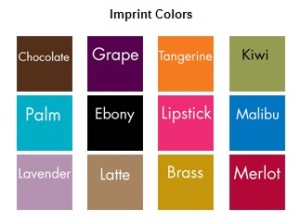 If you are looking into promotional products for your business, you may be slightly floored by all the different terms you come across when it comes to imprint colors. Some of the terms that you may have seen include PMS, CMYK, spot color and more. Unfortunately, you won’t really get to know the differences between these terms until you have been involved in creating or ordering promotional products for quite some time. Luckily, however, the terminology is actually quite easy to understand, so long as you know what you are looking for.
If you are looking into promotional products for your business, you may be slightly floored by all the different terms you come across when it comes to imprint colors. Some of the terms that you may have seen include PMS, CMYK, spot color and more. Unfortunately, you won’t really get to know the differences between these terms until you have been involved in creating or ordering promotional products for quite some time. Luckily, however, the terminology is actually quite easy to understand, so long as you know what you are looking for.
What Are Imprint Colors?
The first thing to understand is what imprint colors actually are.
“The imprint color is the color of the ink used when putting your logo on your item. This ink is loaded into the printer and pressed along the surface of the screen or pad to then be transferred to your promo item.”
You must make sure, therefore, that you understand the difference between imprint color and item color. The item color is the color of the actual promotional item you have purchased. The imprint color is the color of whatever it is you want printing on that item. You must be careful with this, as you can’t use the same color for the two, as your logo or text will then be invisible. The possible combinations are endless, however.
PMS Color Models
PMS stands for Pantone Matching System and is used in almost all imprint color activities. However, it is generally only used if the company uses spot colors to make the prints.
“Most applications that support color printing allow you to specify colors by indicating the Pantone name or number. This assures that you get the right color when the file is printed, even though the color may not look right when displayed on your monitor.”
Spot Colors
The technique of using spot colors means that no screens or dots are used in the process. Colors are mixed in the same way as people mix yellow and blue together in order to create green, only in a much more precise and controlled method. More often than not, these colors are only used in processes where not much variety in colors is needed, not in the least due to the fact that there is only a gamut of 14 basic colors.
CMYK Color Models
If you use process colors rather than spot colors, it is generally more appropriate to use CMYK color models. Here, the colors cyan, magenta, yellow and black (CMYK) are used, and combining these four in different ways allows you to create any color you could possibly want.
Process Colors
Unlike spot colors, process colors use screens and dots to mix the four colors of the CMYK model.
“During separation, screen tints comprised of small dots are applied at different angles to each of the four colors. The screened separations are then transferred to four different printing plates, one for each color, and run on a printing press with one color overprinting the next. The composite image fools the naked eye with the illusion of continuous tone.”
Indeed, this is the system that is generally used for highly detailed images, including photographic printing. It allows for any color to be created, above and beyond the standard shades of a certain color. Additionally, using this system is generally cheaper, because there is no need to use separate plates for each color that is needed in the design. Unsurprisingly, most printing companies will focus more specifically on process colors and the CMYK model for their imprint colors, although spot is equally possible.










